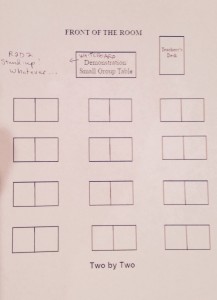(This is another quick, down and dirty post for new teachers. If readers know anyone who is just getting started in the field, please pass on this URL. I am oversimplifying my topic a bit, but I would like to make the first few months of teaching easier for men and women tackling their first assignment.)

At some point while taking education classes, prospective teachers will confront pictures of various possible desk arrangements for a classroom. These future teachers will discuss the advantages and disadvantages of various set-ups, a discussion that often suffers from a reality deficit, especially if there are no experienced public school teachers in the classroom. Many education professors have taught only briefly in public schools and sometimes then not for decades.
My next piece of advice is for any newbies in the field: Scrap any seating arrangement in which students regularly face each other. Clustering students in tight groups also should be avoided. Foursomes are not your friend.
I personally favor seating students in pairs. Students can be angled so everyone can see the teacher and audiovisual equipment at the front. Pairing provides convenient seat partners to work with. For group work, alternate pairs can turn their desks around to make foursomes. I have also had some success with “U” shapes in which the desks on the side face in and desks in back face towards the front. This shape tends to work well in smaller classes.
The truth is that old-fashioned rows work very well, but they are unfashionable. If you plan to look good to administrative visitors, you probably want to avoid rows. Small groups are all the rage right now, and rows may convey the impression that you are doing whole group instruction, rather than small groups. Since administrators only catch snippets of instruction and may not see many minutes of your actual work, creating the right first impression needs to be a priority for you.
Eduhonesty: When in doubt, ask a more experienced colleague for help in laying out classroom desks, but keep in mind that teaching becomes easier with time. After a few years, some teachers can work with groups of four, even if students are not automatically facing front. That takes experience and a strong hand, though.
For anyone new to the profession, I strongly recommend making life simple. Pairing students in rows should prove the most manageable set-up for starting out. You can always change a set-up that is not working, but I recommend not making too many changes too often. Continuity helps a classroom gain its footing.
The Internet is filled with sample seating charts, of course. Some provide help for addressing specific behaviors. One last piece of advice: If you are not sure you have the right chart, go back to the drawing board. You will want to live with your chart for weeks or preferably months. Putting careful thought into desk placement upfront prevents hours of aggravation and numerous phone calls home later.
